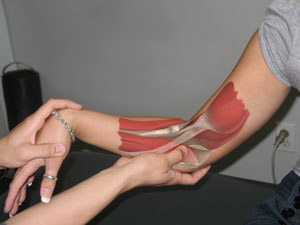
Eccentric Muscle Training with Tirante Musculador
January 17, 2016
Tight calves?
January 31, 2016Active Release Technique is a patented, state of the art soft-tissue system that is movement based and uses hands-on evaluation and a case-management system that allows a practitioner to diagnosis and treat soft-tissue injuries; using over 700 specific protocols, the clinician is able to evaluate the tightness, texture and overall movement of the muscles and tissues then effectively treat the root cause. Soft tissue refers primarily to muscle, tendon, fascia, and nerves.
The main concept of ART is to re-establish motion between fascial planes resulting in a reduction of fibrous adhesions and re-establishing myofascial glide between tissues. Every ART session is a combination of examination and treatment. The ART provider uses his/her hands to evaluate the texture, tightness, and movement of the muscles, fascia, tendons, ligaments, and nerves. Abnormal tissues are treated by combining precisely directed tension with very specific patient movement.
Whether a condition is chronic or acute, ART works effectively by breaking down the adhesions between cross-fiber muscles to restore full motion and function and additionally, alleviating pain and improving function.
Many common ailments can be attributed to weak or tight soft tissue, repetitive strain injury, adhesions, tissue hypoxia, and joint dysfunction, some examples are:
- Headaches
- Sciatica
- Neck/Back Pain
- Shin Splints
- Patellofemoral pain syndrome
- Iliotibial band friction syndrome
- Swimmer’s shoulder
- Tendonitis/Tendonosis (Tennis &/Golfer’s Elbow, Achilles Tendonosis, etc.)
- Carpal Tunnel Syndrome
- Muscle strains and ligament sprains
- Plantar Fascitis/fasciosis
These conditions all have one important thing in common; they are often a result of overuse and repetitive motions.
www.youtube.com/watch?v=T1bMbN9VgBM
How do overuse and repetitive strain injuries occur?
Over-used muscles (and other soft tissues) change in three important ways:
- acute conditions (pulls, tears, collisions, etc)
- accumulation of small tears-repetitive strain and pressure and/or tension injuries (micro trauma)
- not getting enough oxygen to tissue (hypoxia)
Over time each of these changes can lead to the formation of scar tissue in the affected area as the body attempts to repair itself. This scar tissue binds-up and ties down tissues that need to move freely. As scar tissue builds up, muscles become shorter, weaker and dysfunctional. This results in increased tension on tendons causing tendonitis/osis, and nerves may become entrapped causing numbness, tingling, and weakness causing reduced range-of-motion, decreased strength, and most often pain.
What should I expect from ART treatment?
During the treatment it is common to feel discomfort during the movement phases as scar tissue adhesions are being “broken up” and fascial planes are being restored. Most people describe the treatment as a “good hurt”. This discomfort is temporary and usually subsides after treatment or with in the next 24 hours. Treatments usually take 8-10 minutes for each area being treated and vary in frequency of treatment from 2-10 visits. It is not unusual for patients to see improvement immediately following treatment. There are no serious contraindications for the use ART, though treatments should be limited to every other day to ensure adequate tissue recovery.
Releasing soft-tissue encourages the body to adapt proper tissue mechanics, thus allowing the body to function optimally. When used in combination with chiropractic manipulation (to restore joint motion) and Graston Technique (to break down scar tissue) you can look forward to living and active life.




